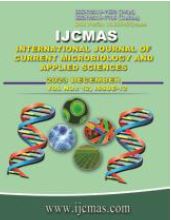


 National Academy of Agricultural Sciences (NAAS)
National Academy of Agricultural Sciences (NAAS)

|
PRINT ISSN : 2319-7692
Online ISSN : 2319-7706 Issues : 12 per year Publisher : Excellent Publishers Email : editorijcmas@gmail.com / submit@ijcmas.com Editor-in-chief: Dr.M.Prakash Index Copernicus ICV 2018: 95.39 NAAS RATING 2020: 5.38 |
A cross sectional study was conducted from 2019 to 2022 at nine slaughter houses and slabs from three different localities in Khartoum state, Sudan, to isolate Escherichia coli from different parts of beef carcasses. A total of 432 dry swab samples from the neck, shoulders, rump, and flanks during pre and post wash, 12 dry swab samples (6 samples prewash and 6 samples post wash) were collected from each slaughter houses and slabs. All Escherichia coli isolated were identified using biochemical reactions and sugar fermentation tests. The mean frequency of Escherichia coli isolated during prewash were: (3.44±2.24, 3.44±1.74, 2.78±1.99 and 3.22±1.48) and (1.89±1.45, 2.44±1.81, 2.00±1.41, 2.44±1.94) during post wash of neck, shoulders, rump and flanks respectively, from all nine slaughterhouses and slabs in Khartoum state, (n=108). Using univariate ANOVA there was significant differences in the frequency of isolates between the four sites of sample collection with p≤ 0.05. The mean frequency of Escherichia coli isolated in Khartoum in pre wash was3.50 and 2.08 in post wash, in Bahri the frequency was 2.41 and1.33 in pre wash and post wash respectively and in Omdurman the mean in prewash was 3.75 and in post wash was 3.167. There were no significant differences in the frequency of Escherichia coli isolation between the three areas of the state, but when the post-hock multiple comparisons was applied there was a statistically significant difference between Bahri and Omdurman slaughterhouses with (P<0.05). In conclusion, the frequency of isolation of Escherichia coli is significantly lower in modern slaughter house that follow the good hygienic practices.
 |
 |
 |
 |
 |